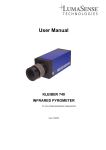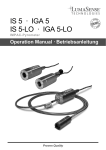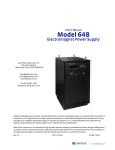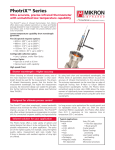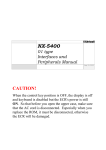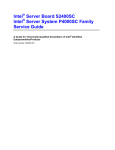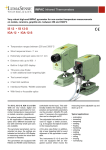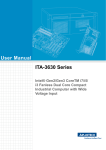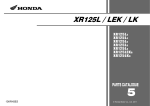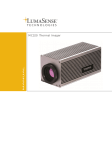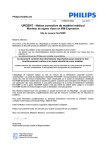Download User Manual - pyrometrcz.cz
Transcript
User Manual KLEIBER 740-LO INFRARED PYROMETER for non-contact temperature measurement Issue 03/2008 Address/Copyright LumaSense Technologies GmbH Kley erstr. 90 D - 60326 Frankfurt Germany Phone: Fax: E-Mail: Internet: +49-69-97373-0 +49-69-97373-167 [email protected] www.Lumasenseinc.com © 2007 IMPAC Sensor GmbH is a subsidiary company of IMPAC group. Any reproduction of this user manual or part thereof, its storage on electronic media and translation of the manual into foreign languages without written approval of the company KLEIBER Infrared GmbH is strictly forbidden. All rights reserved. X I Table of Contents 1 1.1 1.2 1.3 1.4 1.5 Basic Information.............................................................................................. 1 Notes for the User Manual................................................................................... 1 Purpose............................................................................................................... 1 Intended Use....................................................................................................... 2 Warranty and Liability.......................................................................................... 2 Scope of Supply.................................................................................................. 3 2 Technical Data.................................................................................................... 4 3 3.1 3.2 Safety 6............................................................................................................... 6 Symbols and signal words used.......................................................................... 6 General Safety Notes.......................................................................................... 7 4 4.1 4.1.1 Technical Description....................................................................................... 8 System Design/Principle of Operation................................................................. 8 Fibre Optics......................................................................................................... 9 Vario Optics......................................................................................................... 9 Fixed Optics......................................................................................................... 9 Operating and display elements........................................................................ 10 Connections and interfaces............................................................................... 11 Connections cable (5 pole).................................................................................11 ......................................................................11 4.1.2 4.1.3 5 5.1 5.2 Transport and Storage.....................................................................................12 Transport of the pyrometer................................................................................. 12 Storage of the pyrometer....................................................................................12 6 6.1 6.2 6.2.1 6.2.2 Starting Up........................................................................................................14 Installation Site Requirements............................................................................14 Installation.......................................................................................................... 15 Fix and connect the pyrometer...........................................................................15 Align pyrometer.................................................................................................. 16 7 7.1 7.2 7.2.1 7.2.2 Operation of the pyrometer ............................................................................ 17 Setting the optic................................................................................................. 17 Adjusting the Parameters.................................................................................. 18 Emissivity........................................................................................................... 18 Mounting.............................................................................................................19 8 Troubleshooting.............................................................................................. 20 9 9.1 9.2 Maintenance and Care.................................................................................... 21 General information........................................................................................... 21 Cleaning the Optics........................................................................................... 21 10 Accessories..................................................................................................... 22 11 11.1 11.2 Taking out of service, Disposal...................................................................... 23 Taking out of service.......................................................................................... 23 Disposal............................................................................................................. 23 XX II Table of Illustrations Fig. 1 Structure of the pyrometer................................................................................. 8 Fig. 2 Vario optics........................................................................................................ 9 Fig. 3 Fixed optic measuring set-up............................................................................ 9 Fig. 4 Operating and display elements.......................................................................10 Fig. 5 Connecting plug for 5-pin connecting cable..................................................... 11 15 Fig. 7 Setting the vario optic head..............................................................................17 Fig. 8 Potentiometer for response time adjustment................................................... 19 XXX III 1 Basic Information 1.1 Notes for the User Manual This user manual describes the structure of the KLEIBER 740-LO infrared pyrometer for non-contact temperature measurement and gives the operators all the necessary information related to installation, operation, de-installation along with information related to maintenance and repairs of the pyrometer. When malfunctions occur, the user manual provides suggestions for their potential causes and their repair. propriate technical expertise including a basic knowledge of temperature measuring technology. Before you use the pyrometer for temperature measurement, you must have read and understood these operating instructions! Keep the manual so that it is available at all times. Take into account all the requirements given in this user manual. This is a pre-condition for: regulations. Document structure and Symbols Operating instructions to be performed in sequence are numbered in chronological order. They are grouped together in operational units and accompanied by the corresponding results. Listings without a sequential order are presented as bullet points and items in sub-lists are preceded by dashes. Safety precautions are shown with pictograms and key words. They provide information about the type, source and consequences of the hazard, and safety precautions. The meanings of the pictograms and key words are explained in the „Safety Instructions“ chapter. 1.2 Purpose contact measurement of surface temperatures on metal, ceramic, plastics and is specially designed for industrial applications as well as applications in the area of research and development. The 730-LO also enables you to solve high speed applications in laser areas by using 1 1.3 Intended Use The KLEIBER 740-LO pyrometer is to be used exclusively for the non-contact plications beyond that area are not allowed! Any damage resulting from this is the sole responsibility of the operator. Proper use of the plant also includes: and storage, assembly, operation and care of the pyrometer ting and environmental conditions ons Among applications/conditions for which the pyrometer is not intended for use are in particular: 1.4 Warranty and Liability The KLEIBER Infrared GmbH offers a warranty of 2 years for the pyrometer starting from the date of billing. The warranty covers manufacturing defects as well as defects which are determined during operation and which can be imputed to defects of KLEIBER Infrared GmbH. In these cases, the pyrometer will be repaired free of charge. The freight charges are the responsibility of the respective sender. KLEIBER Infrared GmbH reserves the right to exchange the equipment or parts of the instrument instead of a repair. After a repair, KLEIBER Infrared GmbH offers a warranty of 12 months on all repaired and/or exchanged instrument components. Deviations from the proper use described in this user manual will result in restricted warranty and liability or the loss in case of damage. Damage to wearing parts (e.g. fuses) is excluded from the guarantee. 2 Warranty and liability claims for personal injuries and/or material damage are excluded if this or these result from one or more of the following causes: KLEIBER Infrared GmbH by inappropriate storage 1.5 Scope of Supply The scope of supply of the pyrometer includes: (KS 740-LO or KG 740-LO or KGA 740-LO) IMPORTANT Connecting cables are not included in scope of delivery. Please order the length for the 3 2 Technical Data Manufacturer‘s data : Manufacturer: KLEIBER Infrared GmbH Name of the pyrometer : KLEIBER 730-LO Design data: Length (basic instrument): 170 mm Width: 70 mm Height: 70 mm Weight: approx. 880 g Characteristic data: Measurement range in °C/ Spectral range in µm: KS 740-LO KG 740-LO KGA 740-LO Measurement outlet analogue: Accuracy: [600 … 1.600] °C [0.85 … 1.05] mm [800 … 2.300] °C [0.85 … 1.05] mm [300 … 1.400] °C [1.58 … 1.80] mm [500 … 2.500] °C [1.58 … 1.80] mm [200 … 1.000] °C [1.58 … 2.20] mm [300 … 2.300] °C [2.00 … 2.20] mm [0 … 20] mA or [4 … 20] mA Reproducibility: Response time t95: adjustable from 0.1…1 Fibre optics: Sighting mechanism: 4 please refer to table below LED pilot light Operating temperature: [0 … +40] °C [0 … +260] °C for optical head and Storage temperature: [-20 … +70] °C Power supply: 24 V DC 0,2 A or 24 V AC 0,2 A Test base: EN 55 011 : 1998, limit class A CE marking: according to EU regulations Fibre optical heads* Measuring distance [mm] Measuring LVA 25 110 … 800 LVO 25 Fibre cable ø [µm] Measuring range Aperture ø [mm] 0.8 … 5.0 200 (red) all 17 80 … 300 1.6 … 4.3 400 (blue) all 18 LVO 25 S-1 115 … 300 0.4 …1.5 200 (red) >400 °C 10 LVO 25 S-2 200 … 240 0.85 … 1.1 200 (red) >350 °C 12 LVO 25 S-3 76 0.3 200 (red) >400 °C 10 LVO 25 S-4 60 0.5 200 (red) all 11 LVO 25 S-5 70 … 200 1.0 … 2.6 400 (blue) all 12 LVO 25 S-6 250 … 500 3.5 … 6.3 400 (blue) all 18 LVO 35 250 … 1000 3.5 … 11.0 400 (blue) all 28 Optic ø [mm] * other optical heads on request 5 3 Safety 3.1 Symbols and signal words used The following symbols and key words are used in the user manual to indicate hazards and instructions. Safety precautions always appear before an action. DANGER Indicates a potentially dangerous situation. Failure to abide may result in light or minor injury and damage. CAUTION Indicates a potentially damaging situation. Failure to abide may result in damage to the product or to anything near the product. IMPORTANT any dangerous or damaging situations to be avoided. REFERENCE TO ENVIRONMENTAL PROTECTION Important instructions for protecting the environment. 6 3.2 General Safety Notes The KLEIBER 740-LO pyrometer has been built in accordance with the currently valid standards of the technology and the recognized safety regulations and ensures the highest safety level. The fundamental safety and occupational safety requirements of applicable laws, standards, and guidelines have been taken into account in the pyrometer design. CE mark. All information related to safety is with reference to the regulations of the European Union currently in force. In other countries, applicable laws, national directives and safety regulations have to be met. Apart from the safety instructions given in these operating instructions, you should also take into account the generally valid regulations for accident prevention and environmental protection as well as the regulations of the respective professional associations and strictly comply with them. Note the general safety instructions: commissioning (see section 6). of the pyrometer. Other cables, especially cables manufactured by your self, are not permitted are not clamped or squashed. components of the pyrometer (housing, optics, cable and pipes). Never operate the pyrometer with damaged components. 7 4 Technical Description 4.1 System Design/Principle of Operation Fig. 1 shows the basic structure of the pyrometer. The basic parts of a pyrometer are the The infrared radiation coming in from the object to be measured is gathered by the lens. spectral range to enter. The rays then pass through to the detector which transforms the infrared radiation into electric signals. These signals are then linearised in the signal processing unit and changed into a standard output signal which can then be read in the display and be used for process control. The operating elements as well as the connections/interfaces are located at the back of the pyrometer (see pages 10 to 11) . Vorsatzoptik Measured Objekt Aperture Pyrometer Aperture Pilotlight fibre optic cable Display 789°C Signal processing unit Filter + Detektor Lens Lens Connections Fig. 1 8 4.1.1 Fibre Optics Vario optics to realise small spot sizes. Ring nut Fibre optics Min. Length (L) Max. Measuring distance Fixed optics meter is given for a certain measuring distance. Ring nut Fibre optics Length (L) Max. Measuring distance IMPORTANT 9 4.1.2 Bedienelemente The controls and indicators are located on the rear side of the device. For the meaning of individual elements refer to legend Fig. 4, for operation of the pyrometer see section 7. 3 Fig. 4 Operating and display elements Operating and display element 10 Meaning 1 Push button for pilot light switch on/ off the pilot light 2 Potentiometer [response time] 3 BNC Output adjustment of response time from 180 µs to 5 s BNC output 0 … 10 V for connection to storage oscilloscope 4.1.3 Connections and interfaces Connection for 5-pole connecting cable The 5-pole plug to connect the instrument is at the rear side of the unit (see Fig. 5). The contacts of the 5-pole plug are arranged as follows: Plug pin Meaning 1 +24 V Supply voltage (DC or AC) 2 Supply voltage 0 V (DC or AC) 3 ground output 4 Analogue output [0 (4) … 20] mA 5 shield Power supply connection and output [0(4) … 20] mA Fig. 5 Connecting plug for 5-pin connecting cable Mounting using various brackets. and socket mounting support with clamp or thread. This mounting plate ensures secure assembly of the pyrometer as well as optimal adjustment with respect to the object being measured (for order data see page 22). 11 5 Transport and Storage 5.1 Transport of the pyrometer CAUTION Environmental factors, impacts and the formation of water condensa tion may damage some components! CAUTION When transporting the pyrometer, take suitable measures to protect all components from environmental factors, impacts and the formation of water condensation! Temporary storage of the pyrometer in the open air is not permitted! Prepare the pyrometer for transport as follows: 1. 3. Switch the pyrometer off so that there is no tension and remove the connecting cable and the signal cable (e.g. protective cap, foil, …). Pack the pyrometer in the original packaging paying attention to the means of transport (see transport instructions below). ü The pyrometer is thus ready to be shipped. It is advisable to use the original packaging for the shipping of the pyrometer. If the original packaging is no longer available, the pyrometer should be shipped in a cardboard box with shock-absorbing PE material. When transporting the pyrometer observe the following instructions: through the effect of force, or careless loading or unloading. severe temperature deviations while transporting. should be inserted and the pyrometer should be sealed together with the desiccator in a protective plastic sheet. operation, then it should be carefully stored in a location protected against dust and humidity (storage conditions - see section 5.2). 12 5.2 Storage of the pyrometer CAUTION Environmental factors and water condensing may damage some com ponents! Store the pyrometer only in dry areas without large variations in temperature! The atmosphere should be free of dust and corrosive vapours! Store the pyrometer appropriately in the original packaging. Put a suitable desiccant inside the packing (e.g. silica-gel) to prevent damage by moisture. Protect the pyrometer against dust through suitable measures. The following climatic conditions are required in the storage room of the pyrometer: 13 6 Starting Up 6.1 Installation Site Requirements CAUTION Measurement errors and damage to the pyrometer through – ambient temperatures too high , - strong contamination of the optics due to dust, smoke, steam or other causes – air pollution,- electromagnetic inter ference sources You must take into account the following climatic condi tions and the requirements of the place of use of the pyrometer! Climatic conditions place of use of the pyrometer: Requirements at the place of use Take into account the following requirements at the place of use of the pyrometer: ergonomic and the legal guidelines for industrial safety in order to ensure safe operation of the pyrometer. concussion and vibration. Note: We recommend using the rail mounting plate available as an accessory for the attachment of the pyrometer as well as a clamping attachment (see page 23). (e.g. radiators). electromagnetic interference sources. measured and that there is nothing in the path of the rays. 14 6.2 Installation 6.2.1 Fix and connect the pyrometer DANGER There is danger of injury and possible equipment damage by connection of cables under power! Never connect cables under power! Make sure that the voltage supply is switched off before connection of the cables to the pyrometer! Install the pyrometer as follows: 1. Mount the pyrometer with the help of the retaining pin and taking into 2. mounting supports with available accessory (page 22). Connect the coloured wires of the 5-pole connecting cable to appropriate connections of a switchboard. 3. 4. Connect the 5-pole connecting cable to the pyrometer at the back of the instrument and to the power supply. Double check stable set up of the pyrometer. ü The pyrometer is ready for use and can be switched on. 15 Pyrometer wire connection 6.2.2 1 - white Supply voltage +24 V (DC or AC) 2 - brown Supply voltage 0 V (DC or AC) 3 - green ground output 4 - yellow Analogue output [0 (4) … 20] mA 5 - green/yellow shield 1 Supply voltage +24 V (DC or AC) 2 Supply voltage 0 V (DC or AC) 3 ground output 4 Analogue output [0 (4) … 20] mA 5 shiled Align pyrometer The pyrometer is equipped with an LED pilot light for accurate alignment of the sensor with the object to be measured. Align the pyrometer with the object to be measured as follows: 1. 2. 3. 4. ü 16 Switch on the supply voltage to the pyrometer. Allow a starting time of approx. 5 minutes for thermo-stabilization. Than the pyrometer has stabilised and is ready to work with the given accuracy. Switch on the pilot light by pressing the push button at the rear side. Make sure that there is nothing in the path of rays. Note: In order to avoid measuring errors, the area of the pilot light must not be larger than the object to be measured If you have a pyrometer with vario optic head, adjust the necessary measuring distance (see page 18). Note: The pyrometer is thus aligned and ready for the temperature measurement. 7 Operation of the pyrometer 7.1 Setting the optic vario optic please adjust the necessary measuring distance as follows: 1. If necessary switch on the pilot light by pressing the [OK] key. 3. Move the vario optic forwards and/or backwards, in order to adjust the pyrometer to the required measuring distance. Note: 4. ü the adjusted distance! After adjusting the measuring distance, lock the annular nut by turning it in a clockwise direction. The vario optic is thus adjusted to the required measuring distance. Ring nut Fibre optics Min. Length (L) Max. Measuring distance Fig. 7 Setting the vario optic head Example: Measuring distance Ø Length L 80 100 120 140 160 180 200 220 240 260 280 300 1,6 1,8 2,0 2,2 2,4 2,6 2,8 3,1 3,4 3,7 4,0 4,3 63,2 60,0 58,1 56,2 55,4 54,6 54,0 53,6 53,1 52,7 52,4 52,1 17 7.2 Adjusting the Parameters 7.2.1 Emissivity The emissivity is the relationship between infrared energy radiated from an object and the radiation energy of a perfect emitter (black emitter) at the same temperature and the same spectral range. The emissivity is material-dependent and of a considerable size in order to be able to determine the temperature of an object accurately without contact. The emissivity of the object being measured must therefore be known and be adjusted at the pyrometer. Adjust the emissivity suitable for the measurement in accordance with the procedural steps on page 18. The adjusted emission value is indicated in the main menu. Typical emissivities for various materials are available on our homepage at www.kleiberinfrared.com under practical knowledge or in relevant literature. emissivity less than 1.0. This difference can be stepless adjusted between 0.1 and 1.0 with the potentiometer at the back of the instrument. 1. First measure the real temperature of measuring object with a contact ther mometer e.g. thermocouple or resistance probes. The “black” temperature (spectral temperature) measured with a pyrometer adjusted to emissivity = 1.0 usually gives a measuring value differing to real temperature because of the real emissivity of <1.0. The value given by the instrument usually will be less than the real temperature. The emission ratio of most materials depends on temperature as well as wave length being measured. You can get a correlation of the temperature scales, if you adjust the pyrometer at the exact temperature with the help of the potentiometer of emissivity. 2. ü After adjusting the emissivity factor through a correlation measurement you can now measure temperatures for the calibrated temperature range at an accuracy mentioned in the technical data. IMPORTANT Please pay attention if you take over table values of emissivity to give the value of emissivity factor at a certain wave length. Adjusting emissivity following table values is not as exactly as adjusting following a comparing measurement. Changing emissivity: With the help of a suitable screw driver and without any violence you can adjust emissivity at the rear side of the pyrometer stepless between 0.1 and 1. 18 7.3 Mounting various brackets. socket mounting support with clamp or thread. This mounting plate ensures secure assembly of the pyrometer as well as optimal adjustment with respect to the object being measured (for order data see page 23). 19 8 Troubleshooting DANGER There is a danger of injury and possible equipment damage through in correct power supply!Let problems relating to an incorrect power supply be eliminated by an electrical specialist! Do not carry out arbitrary work on the electrical components of the pyrometer! Only eliminate such problems yourself when their causes obviously relate to incorrect power supply, under-cooling or contamination of the lens. Do not undertake any interventions into the pyrometer. If problems arise which do not relate to the causes mentioned above, inform the service staff of the KLEIBER Infrared GmbH (for contact data see page 22). Fault Pyrometer does not provide any measured values Cause Power supply faulty or interrupted If the pyrometer supplies inaccurate measured values dirty optics or condensation or measured values which on the lens lie outside the range to be expected 20 Solution - Check the power supply - Check plugs and connections - Inspect cable Clean optics (see section 9.2) 9 Maintenance and Care 9.1 General information CAUTION Humidity can lead to the destruction of the electrical and electronic components! Do not use any liquids for cleaning the pyrometer or cleaning the immediate environment of the pyrometer! IMPORTANT The servicing period depends particularly on the operating and the operator! The pyrometer is largely maintenance-free. Its function depends, however, considerably on the condition of the optics. The optics must therefore be checked and if necessary cleaned at regular intervals according to the operating and environmental conditions (see section 9.2). This is necessary in particular if the measured temperature levels do not lie in the expected range In the case of excessive contamination or scratches of the optics, please contact the technical customer service (contact address - see page 22). seating. 9.2 Cleaning the Optics Clean the lens with a soft cloth or cotton pad and with white spirits. The optics is thus cleaned and the pyrometer is again ready for use. 21 10 Accessories Electrical accessory 5-pole connecting cable for power supply BNC connecting cable, length 4 m (other length on request) Power supply KNG-0 Power supply KNG-2 Optical accessory Fibre optics cable ( 1,5 m to 25 m) Optical scanner SC 1 Maximum value storage (only in combination with SC 1) Mechanical accessory Ball and socket mounting screw mounted M12 Ball and socket mounting clamp mounted M12 Mounting support for optical head Air purge unit Order information: Please send your orders for accessories to the following address. When ordering, please quote the pyrometer type, the name of the accessory part, and the quantity. Service address: LumaSense Technologies GmbH Kley erstr. 90 D - 60326 Frankfurt Germany Phone: Fax: E-Mail: Internet: 22 +49-69-97373-0 +49-69-97373-167 [email protected] www.Lumasenseinc.com 11 Taking out of service, Disposal 11.1 Taking out of service DANGER Removing electrically live cables risks injury and damage to equipment. Never remove electrically live connecting cables. Before removing a cable, ensure that the power supply has been switched off. Take the pyrometer out of operation as follows: 1. 2. 3. Switch off the power supply to the pyrometer. Remove the cables at the rear side of the pyrometer. Remove the connections of the cooling system and empty the remaining cooling water from the cooling ducts of the pyrometer. Dismantle the pyrometer from the mounting plate. If necessary bring the optics in and tighten the annular nut. 4. 5. ü 11.2 The pyrometer is thus out of operation. Disposal For disposal, you can return the pyrometer to KLEIBER Infrared GmbH (for address see page 23). For this you should pack the pyrometer appropriately in the original packaging or use a cardboard carton with shock absorbing PE material. REFERENCE TO ENVIRONMENTAL PROTECTION Do not dispose of the pyrometer with domestic refuse! 23




























